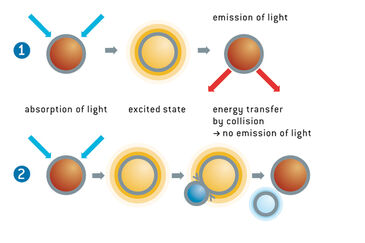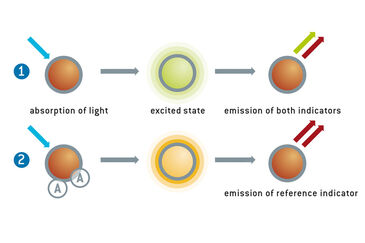Watch tutorials, webinars and informative videos about PreSens optical sensor systems.
Measurement Principle of Chemical Optical Sensors
The Smart Measurement Method
A fluorescent indicator dye - sensitive to the respective analyte - is embedded in a polymer matrix, which can be coated on different supports, allowing for most different sensor designs.
Watch a short animated video on how our optical sensor spots and non-invasive measurement through transparent vessel walls work!
Optical Oxygen Sensors
The light from an LED excites the optical oxygen sensor to emit fluorescence. If the sensor encounters an oxygen molecule, the excess energy is transferred to this molecule in a non-radiative transfer, decreasing or quenching the fluorescence signal. The degree of quenching correlates to the oxygen partial pressure of the analyte in the matrix, which is in dynamic equilibrium with the oxygen in the sample. The decay time measurement is internally referenced.
Optical pH and Carbon Dioxide Sensors
For our optical pH and CO2 sensors a patented Dual Lifetime Referenced (DLR) method is used, which enable internally referenced measurements. A combination of different fluorescent dyes detects intensity changes in the time domain. The luminescence lifetime measured is a superposition of the signals of an analyte sensitive indicator and an inert reference indicator, where both indicators exhibit very different luminescence lifetimes and the luminescence of the analyte sensitive indicator can be supressed by the analyte. It is essential for the pre-calibrated measurements and the easy parallelisation of measurements through the identical calibration of large numbers of sensors.




